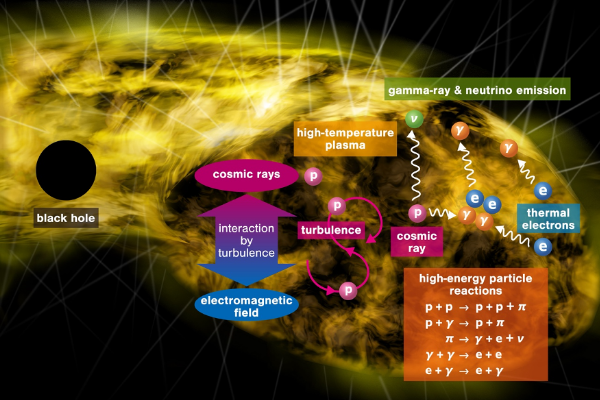Reviewed by Alex SmithSep 27 2021
Energetic particles like X-rays, neutrinos and gamma rays fill the Universe. Yet, the origins of a majority of the high-energy cosmic particles remain inexplicable.
 A schematic picture of mellow supermassive black holes. Hot plasma is formed around a supermassive black hole. Electrons are heated up to ultrahigh temperature, which emits gamma rays efficiently. Protons are accelerated to high energies, and they emit neutrinos. Image Credit: ©Shigeo S. Kimura.
A schematic picture of mellow supermassive black holes. Hot plasma is formed around a supermassive black hole. Electrons are heated up to ultrahigh temperature, which emits gamma rays efficiently. Protons are accelerated to high energies, and they emit neutrinos. Image Credit: ©Shigeo S. Kimura.
A new scenario has been suggested by an international group of researchers; black holes that have low activity serve as significant factories of high-energy cosmic particles. The findings of the study have been reported in the Nature Communications journal.
Gamma rays are known to be high-energy photons that are many orders of magnitude more energetic compared to visible light. Cosmic gamma rays that have energies of megaelectron to gigaelectron volts have been detected with the help of space satellites.
Neutrinos are subatomic particles whose mass seems to be almost zero. Their interaction is quite rare with ordinary matter. At the IceCube Neutrino Observatory, high-energy cosmic neutrinos have also been quantified by scientists.
Both neutrinos and gamma rays must be made by strong cosmic-ray accelerators or encircling environments in the universe. Yet, their origins are yet to be known. It is generally considered that active supermassive black holes (alleged active galactic nuclei), particularly those with powerful jets, are the most promising emitters of high-energy neutrinos and gamma rays.
However, the latest studies have shown that they do not give an explanation of the observed neutrinos and gamma rays. This indicates that other source classes are essential. The latest model demonstrates that not only active black holes but also non-active, “mellow” ones are essential, which serve as neutrino and gamma-ray factories.
All galaxies are anticipated to hold supermassive black holes at their cores. When matter drops into a black hole, a massive amount of gravitational energy is discharged. This process helps to heat the gas, thereby developing high-temperature plasma.
The temperature can attain a range that is as high as tens of billions of degrees Celsius for low-accreting black holes due to inefficient cooling, and the plasma has the ability to produce gamma rays in the megaelectron volt range.
These mellow black holes are dim as individual objects, but they are found to be countless in the universe. The research group has discovered that the consequent gamma rays emitted from low-accreting supermassive black holes might add up considerably to the noted gamma rays in the megaelectron volt range.
Protons present in the plasma could be expedited to energies that are approximately 10,000 times higher compared to those achieved by the Large Hadron Collider, which is known to be the largest human-made particle accelerator. The sped-up protons generate high-energy neutrinos via interactions of matter and radiation, which can explain the higher-energy part of the cosmic neutrino data.
This picture applies to active black holes as illustrated by early research. The supermassive black holes, such as active and non-active galactic nuclei, could describe a large fraction of the observed IceCube neutrinos in an extensive energy range.
It is essential to conduct multi-messenger observational programs in the future to determine the origin of cosmic high-energy particles. The suggested scenario predicts gamma-ray counterparts in the megaelectron volt range to the neutrino sources.
A majority of the present gamma-ray detectors are not tuned in such a way to detect them; but gamma-ray experiments in the future, along with next-generation neutrino experiments, will be able to identify the multi-messenger signals.
Journal Reference:
Kimura, S. S., et al. (2021) Soft gamma rays from low accreting supermassive black holes and connection to energetic neutrinos. Nature Communications. doi.org/10.1038/s41467-021-25111-7.